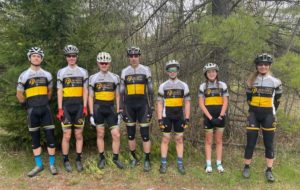
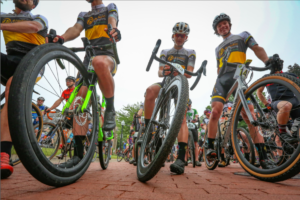 Jonathan often competes with Hunter, and took 2nd to him at the Grit and Gravel, while also winning the Open Expert class at Pontiac Lake, and taking 11th at Hart Hills in the Elite field.
Jonathan often competes with Hunter, and took 2nd to him at the Grit and Gravel, while also winning the Open Expert class at Pontiac Lake, and taking 11th at Hart Hills in the Elite field. AthleticMentors.com
AthleticMentors.com
 Jonathan often competes with Hunter, and took 2nd to him at the Grit and Gravel, while also winning the Open Expert class at Pontiac Lake, and taking 11th at Hart Hills in the Elite field.
Jonathan often competes with Hunter, and took 2nd to him at the Grit and Gravel, while also winning the Open Expert class at Pontiac Lake, and taking 11th at Hart Hills in the Elite field.By: Bob Schultz
The Grand Rapids Tri was my first triathlon nine years ago. I average five tri’s a year including Xterra off road triathlons. The Grand Rapids Tri in the Olympic distance was my third of 2021 season. The first on the year was in Oak Mountain, Alabama with the Xterra SE Championships where the temperatures and humidity were in the 80’s then I did the Greenville Tri two weeks ago.
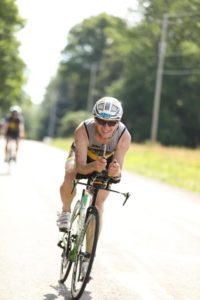
Photo By: Stellafly
I approached this year’s race knowing I had trained better than any other year and felt good about aging up to the 65-69 age group, which yes, made me the youngster. I enjoyed the rolling start for the swim and averaged within 4 seconds of my training swim pace and had a good bike ride within ½ mile off my planned pace, so I took off on my run feeling good wanting to do a 10 minute pace. I took my normal “Gu” in the transition followed by a swallow of water and headed out. I saw another guy in my age group in transition, so knew he was relatively close behind me.
The run-out on Thornapple Drive went as planned. I stopped at both aid stations on the way out and took my cup of Gatorade and water before heading off again. After the turn, I started to feel the heat a little more. Instead of cruising to the aid station, I could not wait to get there for my Gatorade and water. After drinking a splash of water, I would dump the remaining on me. Both stations had cups of ice, but I declined. I remember the final station throwing my cup in the basket and missing. My training teammates rode bikes out by me to encourage my final kick before they headed back to the finish line to watch for me. This is where things got bad. I thought I tripped and fell forward hitting my head on the pavement before the Camel Back bridge. I actually made it to the bridge and started staggering which caught the attention of a lady who is coached by Athletic Mentors and is in healthcare. She asked if I was okay, and I responded yes. This tipped her off I was not and started towards me. I apparently was trying to get myself to the side of the bridge, saw her and reached to her when I fell down face first. A volunteer on a cart was driving by and stopped and helped get me sitting up. The lady took my heartrate at 200 with erratic and shallow breathing. They got me in the cart and took me to the med tent where I was put in a chair and given water until I felt I could stand. Cheryl stopped to check on me and I assured her many times I just tripped. Only after a nap back home did I realize I had no memory from the time my teammates left until the med tent. If not for the lady who saw and helped, I would not know what really happened.
My takes on this episode are:
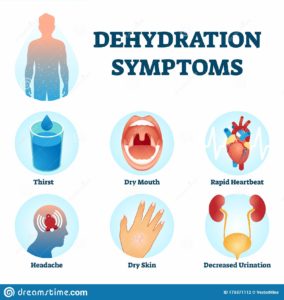
When my teammates told me I was not looking good and could slow down I should have listened to them. These guys train with me multiple times a week and know me as well as I know myself. Most importantly you know yourself best and need to listen to your body. While I did a couple of 15 second walks, when I felt myself heating up I should have walked until I felt my heartrate go down. I knew I was pushing myself, but I continued.
My incident turned out fine. I have had an EKG which was normal and will have an echocardiogram to rule out a heart issue and confirm it was just the heat and dehydration. I may not be so lucky the next time if I don’t keep track of myself. You do the same!
By: Hunter Post
I am a Multi-Sport athlete and High School student. I compete in alpine ski racing, and cycling. Alpine ski racing consists of Slalom, Giant Slalom and Super G. I have raced gravel and mountain bike, and plan to add road racing this season. People find it hard to believe that a fall and winter sport can take up an entire year. My ski season starts in November, and 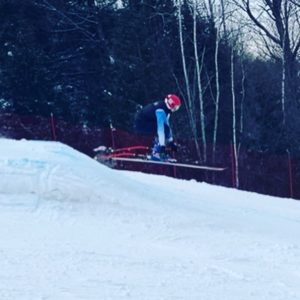 continues until April. I start cycling in April and ride until November with about 2 weeks off in between the seasons. These two very different sports take up most of my time and energy, I am so grateful for where they’ve brought me.
continues until April. I start cycling in April and ride until November with about 2 weeks off in between the seasons. These two very different sports take up most of my time and energy, I am so grateful for where they’ve brought me.
The social aspect of each sport is important to me. I have met so many new friends that have similar interests and have fun both training and racing with them. In skiing, my coaches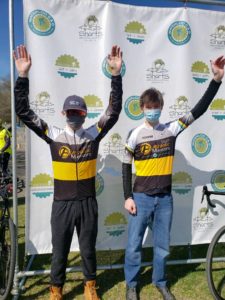 emphasize a balance between having fun on the hill and training; the same applies in cycling, too. Having friends to ski or bike with for fun helps me to do that. Some of my closest friends that I train with are also my competitors which pushes us to work harder and gives us the opportunity to learn from each other. In each sport I am part of multiple teams, from my high school ski and mountain bike teams to competitive teams outside of school. I look forward to these practices because of the team atmosphere and to see my friends.
emphasize a balance between having fun on the hill and training; the same applies in cycling, too. Having friends to ski or bike with for fun helps me to do that. Some of my closest friends that I train with are also my competitors which pushes us to work harder and gives us the opportunity to learn from each other. In each sport I am part of multiple teams, from my high school ski and mountain bike teams to competitive teams outside of school. I look forward to these practices because of the team atmosphere and to see my friends.
On the teams I belong to, there are athletes with varying skill levels and passion for racing. Belonging to these teams gives me a chance to practice more, work with more rigorous coaches and gain experience. I hope to pursue both of my sports at the collegiate level in two years and hope that this will help my chances. In ski racing, we train for the different disciplines separately. For example, setting a slalom course only helps the athletes get ready for a slalom race. There are a few fundamentals including staying on your feet, finding good balance and knowing when to initiate a turn, but the course is set for only slalom or giant slalom, never for both. In cycling there is more crossover on the training. Mountain bike training helps in gravel races. Handling skills for the trail translate into easier passing in sketchier portions. Training for endurance on my road bike correlates into mountain bike races by helping me to manage my breathing and know how to pace myself.
For me, skiing and cycling are like Yin and Yang because my life would not be complete without either.
It helps me to stay focused on one sport at a time, always looking forward to the next season and a chance to start over. Each season has triumphs and defeats that I learn from. It is a cause for celebration when races go well, but honestly I learn more when they don’t go as I hoped. A ski race allows very little room for error. The smallest mistake can change an entire run and two runs are needed to complete a race. Results are often determined by hundredths of a second, so everything has to go right to achieve the results you are looking for. In a mountain bike race, you have more room for error, including falling or mechanical issues. You can overcome the problems you might face in a bike race since you have at least an hour if you face a setback.
By the time one season is coming to an end, I am more than ready for the next to start. I logged 5000 cycling miles in 2020 and couldn’t wait to get on snow. When my last ski race ended on March 21 of this year, I eagerly packed up my winter gear and waited not very patiently to get on my bike. People always ask me which I like better, and I tell them that I can’t answer that yet and don’t have to choose. Each have different workouts, muscle groups, and race atmosphere. I have found, however, that I am not alone. There are a few of us that both ski and bike race. They go together well, just like yin and yang. I am grateful that I found each of my sports. I hope to continue skiing and biking for the rest of my life.
By: Jared Dunham
 The KRanza 170, is the “best kept secret” ultra-gravel ride in mid-Michigan. Notorious for it’s sand, last year’s ride was given the nickname of “The Sandza”, on account of the course primarily being built from sandy two-track. To give some context, the fastest time from last year’s course was a spicy 12:57:55, laid out by Paul Low. Rob Richardson went as far as to name his Strava ride, “I’d rather cut off my legs and eat them before riding that course again!”. Roy Kranz, the event organizer, promised less sand this year and he delivered with the new and improved 2021 course.
The KRanza 170, is the “best kept secret” ultra-gravel ride in mid-Michigan. Notorious for it’s sand, last year’s ride was given the nickname of “The Sandza”, on account of the course primarily being built from sandy two-track. To give some context, the fastest time from last year’s course was a spicy 12:57:55, laid out by Paul Low. Rob Richardson went as far as to name his Strava ride, “I’d rather cut off my legs and eat them before riding that course again!”. Roy Kranz, the event organizer, promised less sand this year and he delivered with the new and improved 2021 course.
The original course was two 85 mile laps which were done on the eastern portion of the route, before crossing over near Evart. This year however, we continued farther west and were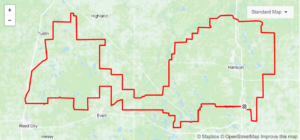 treated with less sand but an added 1,500 ft of elevation. With more hard packed gravel and less sand, my tire choice was a 29×2.1” MTB tire on the front and a 700x42c gravel tire on the back. In addition to this, we also got some rain for two days prior to the event so the sand was reduced even more. One last note, while some of us were riding 170 miles, there was also the option to complete one lap of the original 85 mile loop.
treated with less sand but an added 1,500 ft of elevation. With more hard packed gravel and less sand, my tire choice was a 29×2.1” MTB tire on the front and a 700x42c gravel tire on the back. In addition to this, we also got some rain for two days prior to the event so the sand was reduced even more. One last note, while some of us were riding 170 miles, there was also the option to complete one lap of the original 85 mile loop.
It was 32 degrees at the start, or 28 by the time you factored in the wind. So I layered up with a normal jersey, thermal long-sleeved jersey, and wind vest. However, by the time you added in the sun and adrenaline, three layers was probably more than what was needed. With how long the ride was going to be, I assumed we would have an easy rollout and somewhere along those 170 miles we’d start racing, that was not the case today. The start of the ride was just as hard as any gravel race I’d done, maybe even more intense. David Messing wasn’t leaving anything to chance as he, Ben Kalis, and a few riders from the 85 mile race formed a group and began setting a hot pace from the start. Realizing the race was getting away from us, I tried to put in a good effort and bridge the gap but wasn’t willing to blow up early in the ride.
A group of five chasers formed to catch the lead group featuring: John Whipple, Jon Delboy, two 85 mile riders, and myself. The rain from the previous days had left the roads muddy, some sections had standing water that we were riding through. Running a 2.1 MTB tire in the front of my rig served me well in these areas and I was able to confidently charge into sloppy sections of the roads. In 8 miles we hit the first section of two-track and I took a pull through the road, having ridden this before. Not too long after this point, we were descending a hill and I was completely sprayed with mud from the wheel ahead of me, thinking that we had a very long day in the saddle at this rate. Somewhere within 13 miles, Ben was off his bike and on the side of the road. He hopped back on and joined our group, forming a peloton of 6. At 15 miles, I realized that my engine was probably still running too hot and I needed to throw some coolant in there or we were about to have a premature explosion at the beginning of a 170 mile race. I fell off the group and settled into a controllable pace in zone 2. Not too long after, I caught up with Jon who had left the group for the same reasons. We joined forces and entered the added 85 mile portion to the original 85 mile loop.
The total elevation from this ride was 6,788 ft, much of that began just after passing Evart at mile 30 and ended at mile 100 as we rejoin the original 85 mile loop. Upon passing Evart, we hit some long, rolling, hill climbs and were eventually rewarded with a little over 10 miles of the paved “White Pine Trail”. Until mile 70 me and Jon took turns hammering out the paved section of this course. Nearing the end of the white pine trail I began to feel myself slipping a little, my heartrate compared to my wattage was rising and I could feel the ride becoming harder than it already was. I was confident that I could still finish the ride but was worried that I’d have to slow the pace. At mile 72 we hit 170th Ave, “The Miracle Mile”. Having lived near this area all my life, I knew fully well what this seasonal road was capable of. When it has been dry for several days, the road is a crusty, clay, path of tire marks and tractor tracks. However, when wet, the road is an entirely different experience….
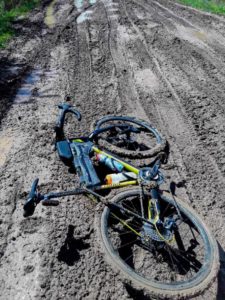
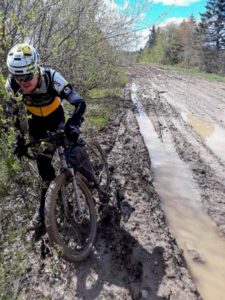 Somehow Jon and I were able to ride about 75% of the mile upright and on our bikes. There were a few moments of slip and slide, but we cleared most of it. Near the end though, the mud got so thick that it was getting stuck in my front fork and shedding off the top of my front tire. The bike quickly packed on the pounds and it was hard to even push it through this peanut butter. Afterwards, we spent a solid 1 5min or more cleaning off bikes and reviving drivetrains. Luckily, Jon had taken some of the spare chain lube that Roy was offering at the start. That saved both of our rides and gears on that day. We agreed that it probably would’ve been a better option to carry our bikes and walk. Not long after starting to ride again I realized that I couldn’t shift out of my small chainring. We stopped and I emptied the remaining water in my backpack water bladder onto the front derailleur. Jon and I cleaned it off using some sticks and found a pebble lodged between the mechanism and the frame. Afterwards, my drivetrain was arguing with me, but I was able to shift into the big ring again. We then began a 7 ½ mile rolling climb to the top of Grove Hill, which depending on who you ask, is either the highest or second highest point in the Lower Peninsula. Upon reaching the top, we are rewarded with a soulful descent to the halfway point at the Dighton general store. Jon grabbed some more water and supplies, and I swapped out my empty water bladder in my backpack for the 2 Liter that was in the bottom of my frame bag. We were then told that 3rd place was probably 30 mins ahead of us at this point, which was about five and a half hours in.
Somehow Jon and I were able to ride about 75% of the mile upright and on our bikes. There were a few moments of slip and slide, but we cleared most of it. Near the end though, the mud got so thick that it was getting stuck in my front fork and shedding off the top of my front tire. The bike quickly packed on the pounds and it was hard to even push it through this peanut butter. Afterwards, we spent a solid 1 5min or more cleaning off bikes and reviving drivetrains. Luckily, Jon had taken some of the spare chain lube that Roy was offering at the start. That saved both of our rides and gears on that day. We agreed that it probably would’ve been a better option to carry our bikes and walk. Not long after starting to ride again I realized that I couldn’t shift out of my small chainring. We stopped and I emptied the remaining water in my backpack water bladder onto the front derailleur. Jon and I cleaned it off using some sticks and found a pebble lodged between the mechanism and the frame. Afterwards, my drivetrain was arguing with me, but I was able to shift into the big ring again. We then began a 7 ½ mile rolling climb to the top of Grove Hill, which depending on who you ask, is either the highest or second highest point in the Lower Peninsula. Upon reaching the top, we are rewarded with a soulful descent to the halfway point at the Dighton general store. Jon grabbed some more water and supplies, and I swapped out my empty water bladder in my backpack for the 2 Liter that was in the bottom of my frame bag. We were then told that 3rd place was probably 30 mins ahead of us at this point, which was about five and a half hours in.
Continuing the ride, I still felt like I was on the back foot and began tapping into some of my gels and more carb rich foods. This was about the portion of a long ride where you reach a low and begin to question how you are going to finish the thing. Eventually I got the second wind I was looking for and came back to life in a few miles. This second wind was quickly followed by the portion of a long ride where you get the euphoric feeling that you can complete the thing. At 107 miles, there had been a serious accident, and someone was being airlifted to a hospital via helicopter. We were not getting through and one of the guys blocking the road said that we had a 20 minute or more wait on the helicopter. The helicopter did eventually land and we spent about 15 minutes scrolling through google maps to get a reroute. The main issue was that we needed to get over the Muskegon River and there were not many options to do that other than take 66 (the road we needed to follow). Our next best bet was to head northeast for a bit and jump onto M115. After some contemplation we decided to go ahead and take the reroute. Motoring through headwind on 115 we made a left at the “Bucksnort Saloon” and were finally back on track. Upon reentering the portion of the course which was the original 85 mile loop, the nostalgia of last year came flooding back to me. We reached the small town of Temple and crossed M61 to enter Strawberry Rd. With the name of “Soulpit”, this four-mile portion of the course is arguably the sandiest. On a bad day your bike will only sink in the sand unless you brought some mountain bike tires. However, we were fortunate enough to have the road well packed down and got through without too much issue.
The next 8 miles was flat gravel till we got to the Leota gas station at mile 134 and took a break. I grabbed a few fig bars and some cheese and crackers to take with me. We ate some gas station pizza with fingers crossed that it wasn’t “from last week” and I downed a Dr.Pepper. Refueled by gas station nutrition, we got back on the road with only 36 miles left. At 140 miles, we hit some rolling hills before the last portion of two-track. This last three-mile section is the primo two-track of the KRanza. A good chunk of it is descent and it’s technical enough that you can make a good case for coasting through some sections. At one point both our rear tires nearly washed out on the edge of a huge mud puddle. Two side-by-sides passed us not long after, and we soon passed them when a truck being pulled from the mud was blocking the road. The remaining 27 miles were mostly rolling hills and felt like a cooldown compared to the first 27. The last portion of the course is through some open farmland which can have some brutal headwind. However, we were spared form the wind and in return got a calm conclusion to the ride. Sort of, there was still a sprint. Not one of the sprinting types, I tried to make an attack on one of the last climbs. However, Jon followed my move easily and we rode together for the last mile.
Making a right onto Clare Ave…
Left onto Hatton Rd….
and Sprint!
Jon takes the sprint.
In total, we finished the ride in 11 hours and 22 minutes. Considering everything that happened along the way, I’d say that’s a pretty solid time. I took 5th, Jon Delroy 4th, John Whipple 3rd (10:48:12), David Messing 2nd (10:18:39), and Ben Kalis 1st with a fiery (9:46:23).
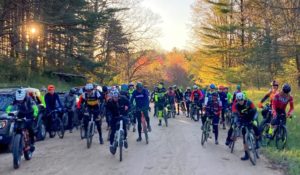 I need to thank Roy Kranz for hosting the KRanza for 6 years, this was my second time completing one of the 170 routes and I feel they present a unique challenge you don’t see at the average gravel ride. With 65 people registered between the 85 and 170 mile race in 2021, I can’t wait to see how the ride changes and evolves as time goes on!
I need to thank Roy Kranz for hosting the KRanza for 6 years, this was my second time completing one of the 170 routes and I feel they present a unique challenge you don’t see at the average gravel ride. With 65 people registered between the 85 and 170 mile race in 2021, I can’t wait to see how the ride changes and evolves as time goes on!
Till next year!
You can find my ride here, the 2021 KRanza route can be found here, and for more information please go here.
Other stuff that happened on the ride
By: Christina Vipond
This was my first opportunity to race Hart Hills The Classic Gravel Road Race. I have never ridden this course in previous years and since it was a last minute addition, there wasn’t time for a pre-ride. That may have turned out to be a good thing.
I did look at the profile on Strava so I knew there was 3000 feet of climbing that included a long, steep climb about 40 miles into the 55 mile race. I did a quick look at the route but figured it would be marked well so no need to study or download it onto my computer.
I did a pre race ride the day before from my home and noted how hard the wind was blowing. The weather report indicated there would continue to be 10 mph winds with gusts the next day. Hills and wind, no problem.
Race day! I arrived in Hart around 8 am to get my packet and to get a good warm up ride in. I rode the finish of the course, which was pavement with some small rollers and downhill to the finish line, much better than a climb at the end.
The 55 mile racers lined up for a mass start at 10 am. The organizer, Raymond Passchier, was making announcements about how the rain did not help the road conditions as they had hoped for. He was also announcing sand at mile 23, a large pothole at mile 32 so stay to the left, and a couple of well marked areas of “rough road”. I was trying to keep mental notes. We started downtown, made a few quick turns, and we were climbing gravel in no time. The wind didn’t seem too bad and the temperature warmed up enough to be comfortable. Then the fun really started.
It only took a couple more turns and we were riding into a strong head wind. No problem, just stay on a wheel, there can’t be a headwind the entire ride. Another turn onto a seasonal road and the thought of “hang on, there is some sand”. I managed that area of sand and was thinking back to the pre-race course announcements, I wasn’t even close to mile 23 yet. Another turn and more sand, and wind, and climbing. Finally, a stretch of true gravel road with a break from riding through the sand, except now there was a cross wind that was blowing the bike all over the place.
I have difficulty grabbing food out of my vest pockets so I was told about the “lick em and stick em” trick for Clif cubes. I decided to try it for this race, two rows of cubes on the tube, ready to give a burst of energy. I quickly learned two rows is not a good idea, a couple fell off in the first few miles but overall the trick was working, at least for the first hour.
By the second hour of the race, the remaining cubes were coated with dust. The wind continued with strong gusts. The sand continued to be constant as well. I was riding a section of gravel road which was pretty much loose sand when I saw a man getting his mail from his mailbox. He looked at me and smiled. I told him I didn’t know I was going to have so much fun riding today. He responded with, “You are a long way from Hart”. This was followed by a short section of pavement which felt so nice to just ride without sand and gusting winds. Then I saw the sign for a sharp right turn. As I got closer, I saw it wasn’t just a sharp turn, but a downhill turn onto a washed out, sandy two-track. I started laughing and asked the volunteer “seriously?” He had a funny smile and shrugged his shoulders.
Somewhere during the third hour of the race, I crested a hill and saw a big pothole, there was no choice but to stay to the left just as the race director had announced. The wind was still gusting when I hit some rollers and barely felt like I was moving going downhill. I was pretty sure I was going to get blown back up. There was another sandy two-track that I was not able to navigate cleanly and had to get off the bike. I grabbed the tube, completely forgetting about the cubes and knocked the remaining 4 into the sand. There was a brief thought of “I should grab those” before coming to my senses. I was near the 40 mile mark and expecting to turn onto a gravel road for the long, steep climb I had noted from the road profile. I rounded a corner on the seasonal road and, of course there it was, not on a gravel road.
I had only 10 miles left and I knew the last few were pavement and downhill. I was excited to hit pavement with about 8 miles remaining. But there was that gusty crosswind and an open farm field, which put me in a complete dust out for a few seconds. A little more gravel and then pavement I recognized from the warm-up ride! I was ready for the downhill finish but one more gust of wind made me stop riding completely because it was pushing me into the lane of an oncoming truck, Mother Nature exerting herself one last time.
Three hours and 39 minutes of hills, wind and sand! Hart Hills The Classic Gravel Road Race 2021 was the most challenging course I have raced yet. It was also the course that made me laugh the most. Raymond and all the volunteers did a fantastic job. I know what to expect from this race next year!
By: Raquel Torres
Sweating can be embarrassing if you are at work, school or a meeting, but sweating could also be beneficial for your health. The almost 1 liter of sweat our bodies produce per day can strengthen our immune system and give us healthy-looking skin.
Doctors, scientists and dermatologists talk about the several benefits of sweating. It is the way the body and the skin protect itself from overheating. Sweating also increases the blood circulation and the drips of sweating is the proof of our body’s built- in mechanism to keep it cool while opening up and unclogging the pores, the dropplets consist primarily of water, sodiums, chloride and potassium to an extent. 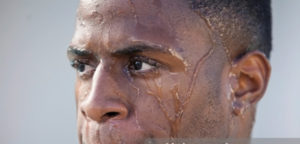
Sweating can flush the body substance of alcohol, cholesterol and salt. In fact, a 2012 study found that sweating plays an important role in expelling heavy metals like mercury, lead, cadmium, and arsenic from the body because they dissolve readily in water. Sweat can’t flush out all toxic compounds, so it’s important to drink filtered water and follow a healthy diet in order to avoid other low-dose chemical threats.
Sweating is an effective way to flush out the salt and retain calcium in our bones. This limits the accumulation of salt in our kidneys and urine, which is where the stones come from.
Group exercises like zumba or hot Yoga, like any other workout, can help to put a smile on your face. Sweating releases endorphins, which are hormones that trigger positive feelings in the body. This can do wonders for your mood and overall well-being.
While you certainly don’t have to venture to a sweat lodge on a hot summer’s day to experience the benefits of sweating, you can find a practice that works for you in order to get in on the feel-good effects of this natural bodily function. Just be sure to recover from any cardio workout or sweat session with plenty of water to keep your body hydrated.
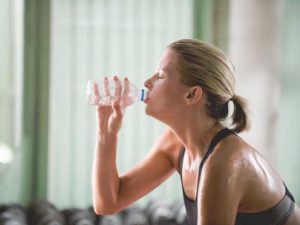 The skin is considered a vital part of the immune system, which makes sense considering it’s often the first line of defense against everything you come in contact with each day. Any bodily fluids are part of this biological defense system, serving as a deterrent for germs to take hold; additionally, human sweat contains a natural germ-killing protein called dermcidin, which can protect against strains of germs and viruses that cause diseases. Several research documents show that these natural substances are more effectives in the long term than traditional antibiotics because germs are not capable of quickly developing resistance to them. The natural antibiotic is naturally activated with salt and slightly acidic sweat.
The skin is considered a vital part of the immune system, which makes sense considering it’s often the first line of defense against everything you come in contact with each day. Any bodily fluids are part of this biological defense system, serving as a deterrent for germs to take hold; additionally, human sweat contains a natural germ-killing protein called dermcidin, which can protect against strains of germs and viruses that cause diseases. Several research documents show that these natural substances are more effectives in the long term than traditional antibiotics because germs are not capable of quickly developing resistance to them. The natural antibiotic is naturally activated with salt and slightly acidic sweat.
First and foremost, sweating is thought to boost weight loss. Yes, you may lose water weight during a session that will inevitably come right back, but because your body is working so hard to cool you down, you’re also using energy and burning calories, which contributes to more permanent weight loss.
Sweat purges the body of toxins that can clog the pores and plague the skin with pimples and blemishes. It can also expel impurities like pollutants, dirt, and makeup embedded in the skin. It’s thought to improve the tone, clarity, and texture of the skin and is known to improve circulation, which can benefit the skin as well.
Although a sweat session alone (like sauna) won’t help you build muscle, it can aid in muscle recovery. Sweating boosts circulation and helps flush out lactic acid, according to researchers this can alleviate soreness and speed up the recovery process.
Putting the body in a situation where it needs to cool itself down by sweating can get your heart pumping similar to a cardio workout. Additionally, research shows that sweating, whether it be from physical exercise or from sitting in a sauna environment, can reduce the risk of cardiovascular health problems. A study published in 2015 by The Jama Internal Medicine; followed Finnish men for 20 years, found that those who sweat in a sauna more frequently were less likely to develop a fatal disease over the course of the study.
So will all this information, let’s get motivated to do your favorite physical exercise and get sweating!
By: Collin Snyder
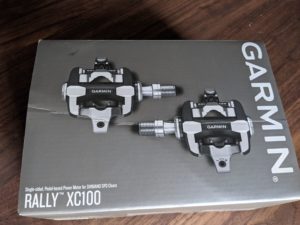 These days, there are countless products out there to measure power. Each type has their own pluses and minuses. Pedal based powermeters have become more and more common over the past five years, although has been mainly targeted towards road bikes. This year, the German company SRM and Garmin have brought this technology to mountain bikes, both using a Shimano SPD style XC pedal. The big benefit of a pedal based system vs a crank based system is it is very easy to swap from bike to bike. With two mountain bikes, a fat bike, and several cyclocross bikes, this benefit is very enticing for me. Earlier this week, I was able to purchase a single sided version of the Garmin XC mountain pedals known as the Rally XC100.
These days, there are countless products out there to measure power. Each type has their own pluses and minuses. Pedal based powermeters have become more and more common over the past five years, although has been mainly targeted towards road bikes. This year, the German company SRM and Garmin have brought this technology to mountain bikes, both using a Shimano SPD style XC pedal. The big benefit of a pedal based system vs a crank based system is it is very easy to swap from bike to bike. With two mountain bikes, a fat bike, and several cyclocross bikes, this benefit is very enticing for me. Earlier this week, I was able to purchase a single sided version of the Garmin XC mountain pedals known as the Rally XC100.
Here is my initial review
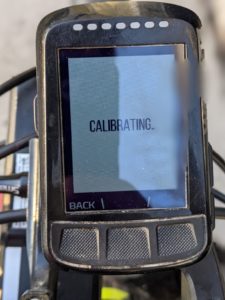 First, pairing was without issue using a Wahoo head unit. It quickly found the ANT signal, and once it was detected, I was able to change the crank length which defaults to 172.5mm. If your cranks are any other length, this must be changed for accurate power numbers. The instructions right out of the box are a little thin as they are mainly just pictorial based. It didn’t give great instructions on how to calibrate. Stages requires the crank to be at 6 o’clock, other powermeters just need the cranks to be still, and older powertaps had to have the cranks spin backwards during the calibration. Googling calibrating the older Garmin Vectors came up saying just calibrate when nothing is touching it. Hitting calibrate the first time, it just kept giving the “calibrating” message for about 30 seconds followed by calibration failed. I hit retry and it calibrated almost instantly, said torque offset 0.0.
First, pairing was without issue using a Wahoo head unit. It quickly found the ANT signal, and once it was detected, I was able to change the crank length which defaults to 172.5mm. If your cranks are any other length, this must be changed for accurate power numbers. The instructions right out of the box are a little thin as they are mainly just pictorial based. It didn’t give great instructions on how to calibrate. Stages requires the crank to be at 6 o’clock, other powermeters just need the cranks to be still, and older powertaps had to have the cranks spin backwards during the calibration. Googling calibrating the older Garmin Vectors came up saying just calibrate when nothing is touching it. Hitting calibrate the first time, it just kept giving the “calibrating” message for about 30 seconds followed by calibration failed. I hit retry and it calibrated almost instantly, said torque offset 0.0.
Right out the driveway/down my dirt road, the numbers seemed inflated quite a bit. The numbers were right around my threshold power which normally I can’t hold until I warm up for a little bit. Fast forward a few minutes and I got stuck at a light. When the light turned green, I did a hard acceleration which was easier than an all-out sprint, my power was in excess of 1000 watts…which unless every other powermeter I’ve owned has been lying to me, wasn’t right.
However, after about 5-10 minutes, the numbers seemed to settle down and were much more believable. The rest of the ride was uneventful. I rode about a 50/50 mix of road and trail. Anyone expecting useful info on a twisty single-track, will be disappointed. Like the mtb powertap and older stages I’ve owned in the past, numbers on the trail are either 500-700 watts or zero. When you get done and look at your average power for a really hard lap, you will surely be underwhelmed. Your average power will probably be only 60-75% of what you could hold on the road for the equivalent time. Power on the mountain bike is really for all that time spent riding to and from the trail unless you are somewhere that has long sustained climbs or long open stretches.
After the ride, one notable oddity was the max power for the ride was severely inflated. It said my max power was around 1300 watts, about 300-400 higher than I will see in an all-out sprint. Comparing my power/time graph, the 1-2 second power was the only thing that was out of whack compared to historical data.
 Ride two was a little more mundane. I recalibrated before the ride. Again, it failed calibration the first time, but when I clicked retry, it gave a successful message. Out the door, power numbers appeared normal/believable. I rode the 4-5 miles to the trail head, did a hot lap of my local trail, and rode home. Once again, my max power was super high at 1500ish watts. I suspect that a single rouge spike is causing the issue. Your 1 second power is a worthless figure, so I am not concerned over these spikes. If the main numbers stay inline, then I am not worried.
Ride two was a little more mundane. I recalibrated before the ride. Again, it failed calibration the first time, but when I clicked retry, it gave a successful message. Out the door, power numbers appeared normal/believable. I rode the 4-5 miles to the trail head, did a hot lap of my local trail, and rode home. Once again, my max power was super high at 1500ish watts. I suspect that a single rouge spike is causing the issue. Your 1 second power is a worthless figure, so I am not concerned over these spikes. If the main numbers stay inline, then I am not worried.
The Garmin Rally XC100 are available now from your local bike shop for an MSRP of $699. For dual sided power, the XC200 are available for $1200.
Special thanks to Sweetbikes in Canton Michigan. In these times, support your Local bike shop.
By: Christina Vipond
The risk of injury is common for athletes and many who mountain bike have their fair share of stories to tell. I learned so much about cycling and racing in my rookie year with a few minor injuries to talk about. The season ended with a fun ride of the Iceman No Cometh, the nicest weather ever for the non-event The next day, I was mountain biking with a friend when my back wheel slid out on dry leaves and down I went. It should have been a non-incident, unfortunately, my left arm was extended when I landed and I heard bones breaking. The doctor from ER reported the X-Rays showed a shattered head of the humerus in my shoulder. The doctor even suggested that given the extent of the injury I might need a total shoulder replacement. Although the news was devastating, I tried to be optimistic, telling myself “at least it is the first day of the off season.”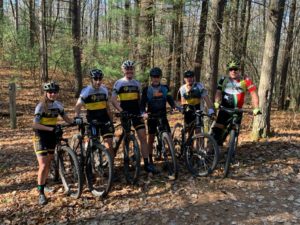
A follow up appointment with a shoulder specialist and sports medicine doctor gave a more positive outlook. The shoulder was not ‘shattered” as the ER doctor described, but the head and upper shaft of the humerus was broken in three places. Surgery took place five days after the break. During the surgery it was revealed that the rotator cuff had been torn and where it attached to the humerus, that piece of bone had been broken. A plate and 11 screws were used to put the bone back together and the rotator cuff was repaired. The doctor was optimistic and said I could be back on the trainer in three weeks. Even with the optimism, shoulder injuries are known to take a long time to heal and I knew that race season started in just over 4 months.
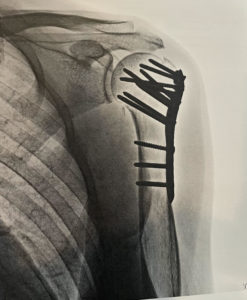 Recovery has different stages and doesn’t always follow a linear path. Proper nutrition is important for athletes and even more so during recovery. I immediately received advice on the best nutritional approach for healing the bone. A diet high in protein,Vitamins C and D, magnesium, calcium and potassium was recommended. As for the arm, the first three weeks focused on resting with as little movement as possible. A sling kept stabilized, great for healing, not so great for everyday tasks that had been taken for granted. Sleeping was difficult due to the sling and fear of rolling onto the shoulder.
Recovery has different stages and doesn’t always follow a linear path. Proper nutrition is important for athletes and even more so during recovery. I immediately received advice on the best nutritional approach for healing the bone. A diet high in protein,Vitamins C and D, magnesium, calcium and potassium was recommended. As for the arm, the first three weeks focused on resting with as little movement as possible. A sling kept stabilized, great for healing, not so great for everyday tasks that had been taken for granted. Sleeping was difficult due to the sling and fear of rolling onto the shoulder.
At the three week mark, I was finally able to get on the trainer. I had been wearing tank tops because they were easy to get on and off. Sports bras were impossible to put on and even harder to take off so I bought front closure sports bras. That was still a challenge with one arm. I learned from watching YouTube videos that I could hold one side with a door jamb while using my right hand to fasten it. I had to get used to wearing glasses while on the trainer because I couldn’t put contacts in. Even putting the heart rate monitor on required a couple of tricks (the door jamb trick worked well for the strap too). Training rides started very easy and with short durations but it was nice to return to a form of normalcy.
Four weeks after surgery I was able to start taking the sling off, begin range of motion exercises and gradually add weight training. This was exciting but also frustrating. Atrophy happens so fast, and rebuilding strength happens so slow. It was nice to have daily encouragement from teammates during this stage. Some days felt like huge gains had been made, but others felt like three steps backwards had been taken. I continued to be diligent with nutrition, arm exercises and increased time and effort on the trainer.
Two months after the surgery, I saw the surgeon again. He took X-Rays and checked the strength and range of motion of the arm. He then said,“I have one question for you, what is your secret to healing so quickly?” I told him, “It’s easy. Proper nutrition, treating rehabilitation like training, and support from friends.” Maybe said differently, I never stopped thinking or acting like an athlete in training. The arm isn’t 100 percent yet but it is strong enough to start the season. I have come to recognize the road back as a journey. While I am not at the final destination yet, I am within striking distance. I will use this season to get the rest of the way there.
By: Raquel Torres
If you want to increase the likelihood of reaching your goals and dreams, visualization is where it all begins. Just as affirmations or mantras are beneficial for motivation, focus, and effective goal setting, so too is a visualization or mental imagery.
It is the use of the imagination through pictures or mental imagery to create visions of what we want in our lives and how to make them happen. Along with focus and emotions, it becomes a powerful, creative tool that helps us achieve what we want in life. If used correctly it can bring about self-improvement, maintain good health, help you perform well in sports, and accomplish your goals in life.
In sports, mental imagery is often used by professional athletes to improve their skills by picturing the achievement of a specific feat, such as hitting or shooting a ball, riding a bike, swimming, or running a race, among other things.
Some benefits of visualization:
By experience, the more I practice this, the better mentally prepared I am before any life event or race week, this increases the possibilities to enjoy the whole process.
It’s a very good habit to do the visualization first thing in the morning, I also do it during training, or before going to bed.
We can apply this technique to anything in our life, big dreams, goals, interviews, speeches, personal life, any life challenge, or skill that we want to improve or learn.
Before any big event or activity, it’s very important to do the full movie in your mind several times. Dreaming is free and legal.
Visualization Scenarios Tips for Triathlete’s Race Week: 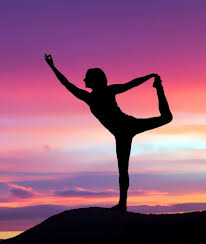
This can help to ease any race day nerves.
For better results start 2 weeks or some days before, visualize for around 5 minutes or more your event, here some examples of scenarios to visualize for a triathlon race day:
The intention of visualization is to prepare your mind and body for the reality ahead of time, when the day comes your mind/body will definitely feel familiar and perform better.
Submitted by: JoAnn Cranson
It’s time to ride bikes year round no matter where you live. I have a wonderful family of “Giant” brand bikes in my garage for the variety of riding I do. Giant brand bicycles is the world’s leading brand of high-quality bicycles and cycling gear. Their focus is being builders and innovators, but to also create a global community of cyclists. Giant owners are athletes, adventurers and advocates for cycling. Some are Tour de France racers, singletrack explorers, neighbors and friends.
I get asked the question on a regular basis by friends “What kind of bike should I get to ride”? Well…. that is a loaded question that only you personally can answer. The bigger question is “Where do you want to ride this bike?”
I can’t answer the question of what bike you should get, but I can certainly help you come to an answer for yourself!
How about I explain each bike and what I use it for along with a picture.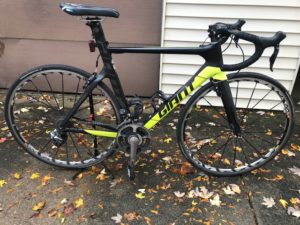
Road Bike (which is my personal favorite) is designed for pavement riding only. This bike is designed for long touring (higher mileage-40+) and group riding on the road. You can go longer distances faster than any other bicycle. The riding position takes some time to adjust to with a more hunched over profile to make you more aero dynamic and the seat is usually smaller and lighter. My “Giant – Propel Model” – is a great ride with an aero design to the bike that allows me to glide down hills like no other!
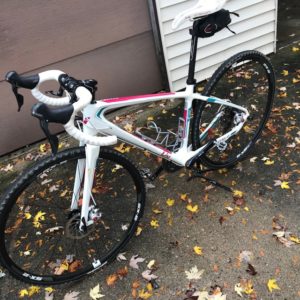 Gravel Bike – OK, so you don’t want to just ride on the roads, you want to ride the Rails to Trails or some gravel roads, I get it. Then we pull out the “Giant – Liv” (Liv models are designed specifically for women) with a more upright position on the bike and knobbier tires that make you feel safe and steady on gravel and unpaved roads, plus you can still easily ride on pavement just at a slower pace. Remember these bikes can have different tires put on them to accommodate what you want to do with them. A smoother tire would allow you to be on the pavement and go faster, but not as easy to handle on gravel.
Gravel Bike – OK, so you don’t want to just ride on the roads, you want to ride the Rails to Trails or some gravel roads, I get it. Then we pull out the “Giant – Liv” (Liv models are designed specifically for women) with a more upright position on the bike and knobbier tires that make you feel safe and steady on gravel and unpaved roads, plus you can still easily ride on pavement just at a slower pace. Remember these bikes can have different tires put on them to accommodate what you want to do with them. A smoother tire would allow you to be on the pavement and go faster, but not as easy to handle on gravel.
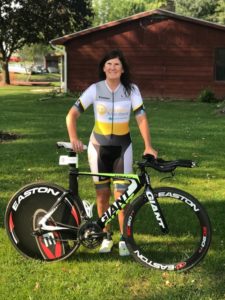 TT Bike – But wait, you are taking up doing triathlons or an Ironman? Well you will want a bike that you can save your energy on, be totally aero-dynamic and pedal as fast as you can! You need a “Giant – TT bike”. This bike can fly as you are laid out on the handlebars to have that air go right over the top of you. TT bikes require a bit of practice to get comfortable with arm position and obtain overall control. But, the energy you can save on these bikes for the run directly after dismounting is well worth the bike choice.
TT Bike – But wait, you are taking up doing triathlons or an Ironman? Well you will want a bike that you can save your energy on, be totally aero-dynamic and pedal as fast as you can! You need a “Giant – TT bike”. This bike can fly as you are laid out on the handlebars to have that air go right over the top of you. TT bikes require a bit of practice to get comfortable with arm position and obtain overall control. But, the energy you can save on these bikes for the run directly after dismounting is well worth the bike choice.
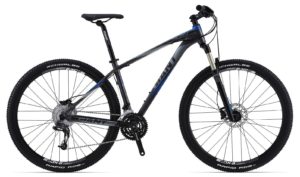 Mountain Bike – You want to enjoy the woods and some adventure? You need a mountain bike that will take you over the logs, bump over ruts and stones and get you through the sand. Now I had a “Giant – 29er Talon” for some time, but like I said, everyone has their personal preferences and mountain biking wasn’t for me. I think I started too late in life and I’m a scaredy-cat and wasn’t comfortable on the rough terrain. But just because it’s not for me, doesn’t mean this isn’t your greatest enjoyment and challenge! This is a great bike for fall and winter pedaling!
Mountain Bike – You want to enjoy the woods and some adventure? You need a mountain bike that will take you over the logs, bump over ruts and stones and get you through the sand. Now I had a “Giant – 29er Talon” for some time, but like I said, everyone has their personal preferences and mountain biking wasn’t for me. I think I started too late in life and I’m a scaredy-cat and wasn’t comfortable on the rough terrain. But just because it’s not for me, doesn’t mean this isn’t your greatest enjoyment and challenge! This is a great bike for fall and winter pedaling!
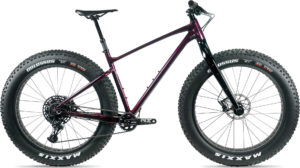 Fat Bike – But what about best of all you “Win” a bike like me last year and get a Fat-Tire Bike!!! This Fat bike is ideal for Winter riding in snow (some people get studded tires) or beach riding in deeper sand, or riding in the woods with a less scary, slower ride. Now these bikes will not keep up with the roadies on pavement, but you can comfortably ride any terrain at a more relaxed pace with nice wide tires to provide security and more bouncy comfort. Giant does offer the Yukon fat tire bike in their lineup.
Fat Bike – But what about best of all you “Win” a bike like me last year and get a Fat-Tire Bike!!! This Fat bike is ideal for Winter riding in snow (some people get studded tires) or beach riding in deeper sand, or riding in the woods with a less scary, slower ride. Now these bikes will not keep up with the roadies on pavement, but you can comfortably ride any terrain at a more relaxed pace with nice wide tires to provide security and more bouncy comfort. Giant does offer the Yukon fat tire bike in their lineup.
 Electric Bike – One bike I don’t have in my family yet is a Giant Electric Bike. Giant offers Electric Bikes in Road, Mountain and Gravel styles. They allow you to ride farther and faster than you thought possible. If you struggle to keep up with younger family members or friends that you want to spend time riding with, this may be an option that is the right fit for you.
Electric Bike – One bike I don’t have in my family yet is a Giant Electric Bike. Giant offers Electric Bikes in Road, Mountain and Gravel styles. They allow you to ride farther and faster than you thought possible. If you struggle to keep up with younger family members or friends that you want to spend time riding with, this may be an option that is the right fit for you.
There are many other styles of bikes I don’t have, check out Giant’s website for their wide array of choices. Whatever bike you pick, just get on it and pedal the way you want to. It’s a great way to exercise without extra strain on knees and other joints. You get those endorphins flowing which pushes stress away. It allows you to spend time with family and friends of varying ages. As you pedal, breathe the fresh air and take time to see the beauty of nature in this journey called life!